Parodia schumanniana
Common Name(s):
Synonym(s): Echinocactus schumannianus, Malacocarpus schumannianus, Notocactus schumannianus, Eriocactus schumannianus, Echinocactus grossei, Malacocarpus grossei, Notocactus grossei, Eriocactus grossei, Parodia grossei, Eriocactus claviceps, Notocactus claviceps, Parodia claviceps, Eriocactus ampliocostatus, Notocactus amplicostatus, Parodia amplicostata
|
| To view publication details for this taxon and related synonyms Click Here. |
| To view a chart comparing alternate taxonomy Click Here. |
|
|
Species Notes: Comment from Alexander Arzberger -See his photos below... I don't want to question here about the correct name, because there are many: Eriocactus grossei, Notocactus schumannianus v. grossei. Although, this form doesn't look like the original Echinocactus schumannianus in the description of Nicolai.
This habitat is situated near the top (540 m) of a small mountain of granite. Most of the mountain is covered with woods and the climate is humid with subtropical vegetation. This Parodia grows only on glades and between rocks (where trees can't grow) and in company of Tillandsias, Dyckias and orchids (Brassavola), a specimen of Peperomia and, on more shady places Selenicereus setaceus, Cereus spec.(forbesii?), Monvillea paxtoniana, Opuntia spec. (retrosa?) and Cleistocactus paraguariensis. In the woods you can find the very large Brasiliopuntia brasiliensis. The soil consits mostly of descomposed bromelia-roots and leaves and is very permeable.
The climate all over the year is warm and humid, with temperatures between 8 and 35ºC. The large rocks act as a heat accumulator, so that frost never happens. Besides this, there is wind almost every day. Sometimes, this mountain is covered with fog through several days and the plants get plenty of humidity. Older cacti are sometimes covered with moss and lichens, so you practically could keep this Parodia like orchids.
This specimen seems not to be endangered for now, because of its high and difficult to reach growing place. Also, these rocks are completely useless for any kind of cultivation. |
 This icon appears next to images that have been 3rd party verified. Click Here to learn more. Click any picture below to enlarge. |
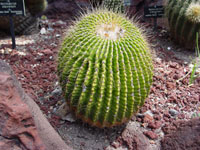
P. schumanniana
|
Picture taken at: Huntington Library and Gardens, San Marino, CA
Photographer: Daiv Freeman
|
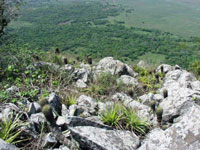
P. schumanniana
|
Picture taken at: Habitat in Eastern Paraguay
Photographer: Alexander Arzberger
|
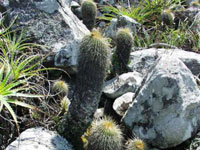
P. schumanniana
|
Picture taken at: Habitat in Eastern Paraguay
Photographer: Alexander Arzberger
|
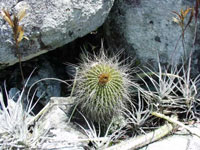
P. schumanniana
|
Picture taken at: Habitat in Eastern Paraguay
Photographer: Alexander Arzberger
|
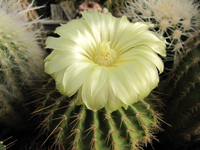
P. schumanniana
|
Picture taken at: Private Collection -Baku city, Azerbaijan
Photographer: Ilham Alekperov
|

P. schumanniana
|
Picture taken at: Gerard Ardisson's Private Collection
Photographer: Gerard Ardisson
Photographer's Website: Click Here
|
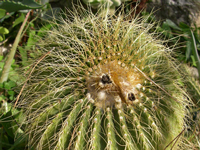
P. schumanniana
|
Picture taken at: Gerard Ardisson's Private Collection
Photographer: Gerard Ardisson
Photographer's Website: Click Here
|
Parodia schumanniana subsp. claviceps
Common Name(s):
Synonym(s): Echinocactus schumannianus, Malacocarpus schumannianus, Notocactus schumannianus, Eriocactus schumannianus, Echinocactus grossei, Malacocarpus grossei, Notocactus grossei, Eriocactus grossei, Parodia grossei, Eriocactus claviceps, Notocactus claviceps, Parodia claviceps, Eriocactus ampliocostatus, Notocactus amplicostatus, Parodia amplicostata
|
| To view publication details for this taxon and related synonyms Click Here. |
| To view a chart comparing alternate taxonomy Click Here. |
|
|
 This icon appears next to images that have been 3rd party verified. Click Here to learn more. Click any picture below to enlarge. |
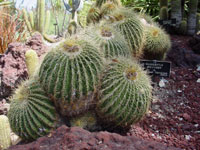
P. schumanniana subsp. claviceps
|
Picture taken at: Huntington Library and Gardens, San Marino, CA
Photographer: Daiv Freeman
|
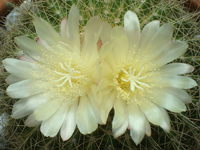
P. schumanniana subsp. claviceps
|
Picture taken at: John and Yingtsih Balcom's Private Collection
Photographer: John Balcom
|
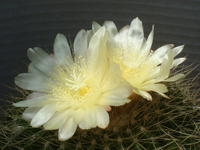
P. schumanniana subsp. claviceps
|
Picture taken at: John and Yingtsih Balcom's Private Collection
Photographer: John Balcom
|
*Currently 66 of 66 known species are represented on CactiGuide.com.
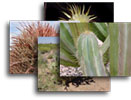
Do you have images of this species that would complement this page?
Visit the Big Picture Project to to learn how you can contribute.
|
|